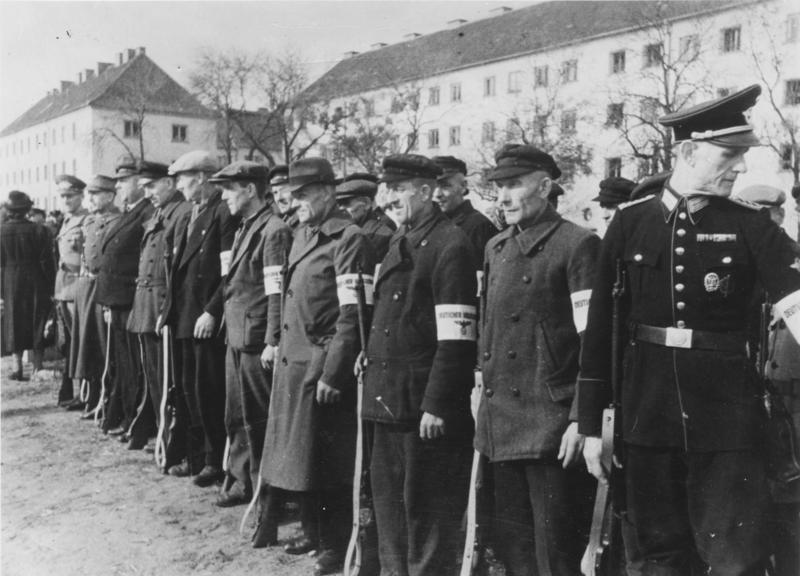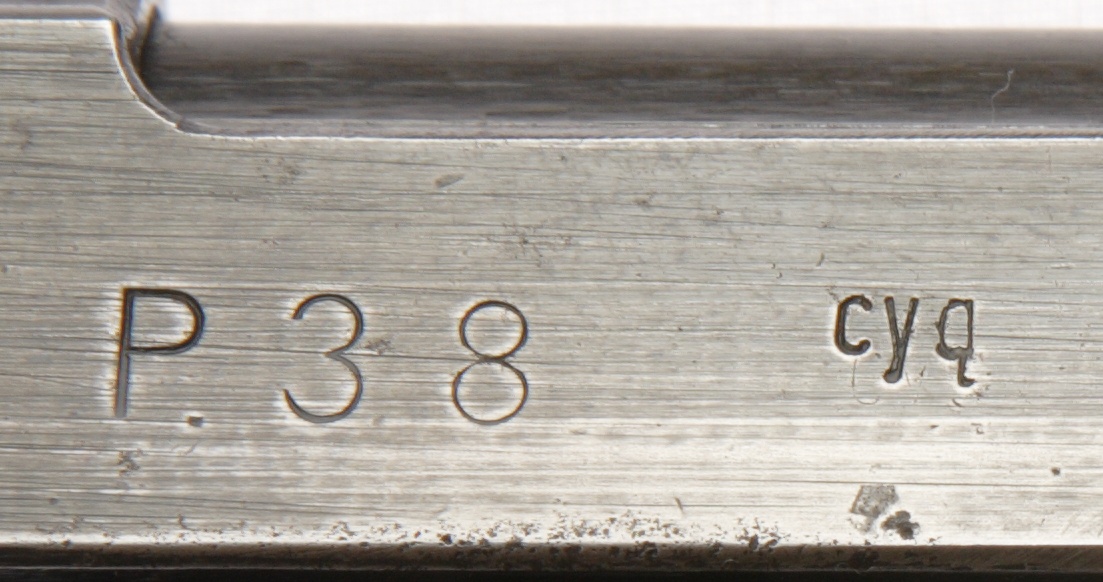|
Volkssturmgewehr 1-5
The Volkssturmgewehr ("People's Storm - Rifle") is the name of several rifle designs developed by Nazi Germany during the last months of World War II. They share the common characteristic of being greatly simplified as an attempt to cope with severe lack of resources and industrial capacity in Germany during the final period of the war. The Volkspistole was a partner program, almost identical, but for pistols instead. The weapon's name can be translated directly either as "People's assault rifle" or "''Volkssturm'' rifle." ''Volkssturm'', the German late war militia home defense force, means "People's Assault"; ''Sturmgewehr'' translates as "assault rifle". ''Primitiv-Waffen''-Programm As a last-ditch measure in the nearly lost war, on 18 October 1944 the ''Deutscher Volkssturm'' was mobilized – a German national militia. To arm them under conditions of depleted manpower and limited available production capacities the ''Primitiv-Waffen-Programm'' ("primitive weapons program") ... [...More Info...] [...Related Items...] OR: [Wikipedia] [Google] [Baidu] |
Volkssturm Gewehr VG 1-5
The (; "people's storm") was a levée en masse national militia established by Nazi Germany during the last months of World War II. It was not set up by the German Army, the ground component of the combined German ''Wehrmacht'' armed forces, but by the Nazi Party on the orders of Adolf Hitler and established on 25 September 1944. It was staffed by conscripting males between the ages of 16 and 60 years, who were not already serving in some military unit. The ''Volkssturm'' comprised one of the final components of the total war promulgated by Propaganda Minister Joseph Goebbels, part of a Nazi endeavor to overcome their enemies' military strength through force of will. ''Volkssturm'' units fought unsuccessful futile battles against the Allied forces at the end of the war and on several occasions, its members participated in atrocities accompanied by German civilians and the Hitler Youth, which were overseen by members of the SS or Gau leaders. Origins and organization The ... [...More Info...] [...Related Items...] OR: [Wikipedia] [Google] [Baidu] |
Walther Arms
Carl Walther GmbH Sportwaffen (), or simply known as Walther, is a German firearm manufacturer, and a subsidiary of the PW Group. Founded by Carl Walther in 1886, the company has manufactured firearms and air guns at its facility in Germany for more than 100 years. Walther Arms, Inc. is the United States Walther business unit and is based in Fort Smith, Arkansas. History The history of Walther started with the factory created by Matthias Conrad Pistor, the chief armorer of the Kassel Armory. Pistor is the ancestor of the Walther family. This plant was operating in 1780 and made pistols and other weapons. The granddaughter of Gustave Wilhelm Pistor married August Theodore Walther, whose son Carl Wilhelm Freund established the factory that employed apprentice Carl Walther. This small shop was established in 1886 in Zella-Mehlis, in what is today Thuringia. The company originally manufactured hunting and target rifles. Then in 1888, he married Minna Georgine Pickert, daughter ... [...More Info...] [...Related Items...] OR: [Wikipedia] [Google] [Baidu] |
Magazine (firearms)
A magazine is an ammunition storage and feeding device for a repeating firearm, either integral within the gun (internal/fixed magazine) or externally attached (detachable magazine). The magazine functions by holding several cartridges within itself and sequentially pushing each one into a position where it may be readily loaded into the barrel chamber by the firearm's moving action. The detachable magazine is sometimes colloquially referred to as a " clip", although this is technically inaccurate since a clip is actually an accessory device used to help load ammunition into a magazine. Magazines come in many shapes and sizes, from tubular magazines on lever-action and pump-action firearms that may tandemly hold several rounds, to detachable box and drum magazines for automatic rifles and light machine guns that may hold more than one hundred rounds. Various jurisdictions ban what they define as "high-capacity magazines". Nomenclature With the increased use of semi-au ... [...More Info...] [...Related Items...] OR: [Wikipedia] [Google] [Baidu] |
Intermediate Cartridges
An intermediate cartridge is a rifle/carbine cartridge that has significantly greater power than a pistol cartridge but still has a reduced muzzle energy compared to fully powered cartridges (such as the .303 British, 7.62×54mmR, 7.92×57mm Mauser, 7.7×58mm Arisaka, .30-06 Springfield, or 7.62×51mm NATO), and therefore is regarded as being "intermediate" between traditional rifle and handgun calibers. As their recoil is significantly reduced compared to full-power cartridges, fully automatic rifles firing intermediate cartridges are relatively easy to control. However, even though they are less powerful than a traditional full-power cartridge, the external ballistics are still sufficient for an effective range of , which covers most typical infantry engagement situations in modern warfare. This allowed for the development of the assault rifle, a type of versatile selective fire small arms that is lighter and more compact than traditional battle rifles that fire full-po ... [...More Info...] [...Related Items...] OR: [Wikipedia] [Google] [Baidu] |
Bundesarchiv Bild 183-J28787, Volkssturmbataillon An Der Oder
, type = Archive , seal = , seal_size = , seal_caption = , seal_alt = , logo = Bundesarchiv-Logo.svg , logo_size = , logo_caption = , logo_alt = , image = Bundesarchiv Koblenz.jpg , image_caption = The Federal Archives in Koblenz , image_alt = , formed = , preceding1 = , preceding2 = , dissolved = , superseding1 = , superseding2 = , agency_type = , jurisdiction = , status = Active , headquarters = PotsdamerStraße156075Koblenz , coordinates = , motto = , employees = , budget = million () , chief1_name = Michael Hollmann , chief1_position = President of the Federal Archives , chief2_name = Dr. Andrea Hänger , chief2_position ... [...More Info...] [...Related Items...] OR: [Wikipedia] [Google] [Baidu] |
Volkssturmgewehr VG 1-5 Suhl
The Volkssturmgewehr ("People's Storm - Rifle") is the name of several rifle designs developed by Nazi Germany during the last months of World War II. They share the common characteristic of being greatly simplified as an attempt to cope with severe lack of resources and industrial capacity in Germany during the final period of the war. The Volkspistole was a partner program, almost identical, but for pistols instead. The weapon's name can be translated directly either as "People's assault rifle" or "''Volkssturm'' rifle." ''Volkssturm'', the German late war militia home defense force, means "People's Assault"; ''Sturmgewehr'' translates as "assault rifle". ''Primitiv-Waffen''-Programm As a last-ditch measure in the nearly lost war, on 18 October 1944 the ''Deutscher Volkssturm'' was mobilized – a German national militia. To arm them under conditions of depleted manpower and limited available production capacities the ''Primitiv-Waffen-Programm'' ("primitive weapons program") ... [...More Info...] [...Related Items...] OR: [Wikipedia] [Google] [Baidu] |
Gewehr 98
The Gewehr 98 (abbreviated G98, Gew 98, or M98) is a German bolt-action rifle made by Mauser, firing cartridges from a five-round internal clip-loaded magazine. It was the German service rifle from 1898 to 1935, when it was replaced by the Karabiner 98k, a shorter weapon using the same basic design. The Gewehr 98 action, using a stripper clip loaded with the 7.92×57mm Mauser cartridge, successfully combined and improved several bolt-action engineering concepts which were soon adopted by many other countries, including the United Kingdom, United States, and Japan. The Gewehr 98 replaced the earlier Gewehr 1888 as the main German service rifle. It first saw combat in the Chinese Boxer Rebellion and was the main German infantry service rifle of World War I. The Gewehr 98 saw further military use by the Ottoman Empire and Nationalist Spain. History The Gewehr 98 was introduced into German military service in 1898, replacing the Gewehr 1888. The bolt-action design was the lates ... [...More Info...] [...Related Items...] OR: [Wikipedia] [Google] [Baidu] |
Steyr Mannlicher
Steyr Arms () is a firearms manufacturer based in Sankt Peter in der Au, Austria. Originally part of Steyr-Daimler-Puch, it became independent when the conglomerate was broken up in 1989. Prior to 1 January 2019, the company was named Steyr Mannlicher AG (). History Origins Steyr has been on the "iron road" to the nearby Erzberg mine since the days of the Styrian Otakar dukes and their Babenberg successors in the 12th and 13th century, and has been known as an industrial site for forging weapons. The privilege of iron and steel production, particularly for knives, was renewed by the Habsburg duke Albert of Austria in 1287. After the Thirty Years' War, thousands of muskets, pistols, and carbines were produced annually for the Habsburg Imperial Army. In 1821, Leopold Werndl (1797–1855), a blacksmith in Steyr, began manufacturing iron parts for weapons. After his father's death, 24-year-old Josef Werndl (1831–1889) took over his factory. On April 16, 1864, he foun ... [...More Info...] [...Related Items...] OR: [Wikipedia] [Google] [Baidu] |
Spreewerk
Metallwarenfabrik Spreewerk GmbH was a German weapons manufacturing company. Spreewerk produced a number of important weapons and components before and during World War II including 280,880 of the Walther P38, Walther P.38 pistol which was the standard service pistol of the German ''German Army (Wehrmacht), Heer'', and the famous 8.8 cm Flak 18/36/37/41, 8.8 cm Flak Anti aircraft gun, anti-aircraft gun. History The Berlin-Karlsruher Industrie Werke (BERKA) was founded in 1920 as a successor to the Deutsche Waffen und Munitionsfabriken AG, one of Germany's largest munitions firms of the prewar era. Under the regime of the Versailles treaty the firm was forced to give up the manufacture of armaments, which had been its core business. Most of the facilities that had grown up to meet the needs of war were reduced and BERKA carried on with factories in Berlin and Karlsruhe, manufacturing a variety of light metal goods. In 1928 the firm passed under the control of Günther Quandt who move ... [...More Info...] [...Related Items...] OR: [Wikipedia] [Google] [Baidu] |
Volkssturmgewehr VG2
The Volkssturmgewehr ("People's Storm - Rifle") is the name of several rifle designs developed by Nazi Germany during the last months of World War II. They share the common characteristic of being greatly simplified as an attempt to cope with severe lack of resources and industrial capacity in Germany during the final period of the war. The Volkspistole was a partner program, almost identical, but for pistols instead. The weapon's name can be translated directly either as "People's assault rifle" or "''Volkssturm'' rifle." ''Volkssturm'', the German late war militia home defense force, means "People's Assault"; ''Sturmgewehr'' translates as "assault rifle". ''Primitiv-Waffen''-Programm As a last-ditch measure in the nearly lost war, on 18 October 1944 the ''Deutscher Volkssturm'' was mobilized – a German national militia. To arm them under conditions of depleted manpower and limited available production capacities the ''Primitiv-Waffen-Programm'' ("primitive weapons program") ... [...More Info...] [...Related Items...] OR: [Wikipedia] [Google] [Baidu] |
Zbrojovka Brno
Pre-war Československá zbrojovka, akc.spol. (or a.s.) (Czechoslovak Armory)and post-war Zbrojovka Brno, n.p.(Brno Armory) was a maker of small arms, light artillery, and motor vehicles in Brno, Czechoslovakia. It also made other products and tools, such as typewriters and early computers. In 1946, Zbrojovka started making tractors, which it branded "Zetor" ("Z-tractor"). Zetor continues to make tractors in Brno. History The company was founded in 1918 as a state-owned factory known as the State Armament and Engineering Works. The factory assembled German Gewehr 98 and Austrian Mannlicher M1895 rifles, but later began producing their own. In 1924–1925 a new factory was built, where cars, engines and other machines were produced in addition to rifles and machine guns. In the 1930s, the factory also produced Remington licensed typewriters and Skoda tractors. During the German occupation of Czechoslovakia, Zbrojovka Brno was renamed to Waffenwerke Brunn and produced weapons f ... [...More Info...] [...Related Items...] OR: [Wikipedia] [Google] [Baidu] |








